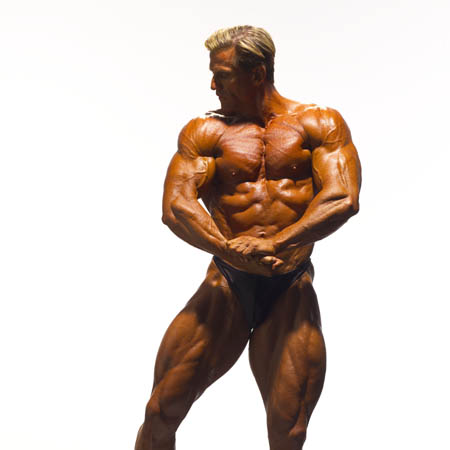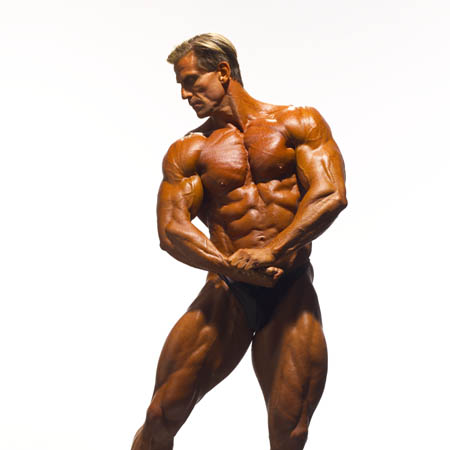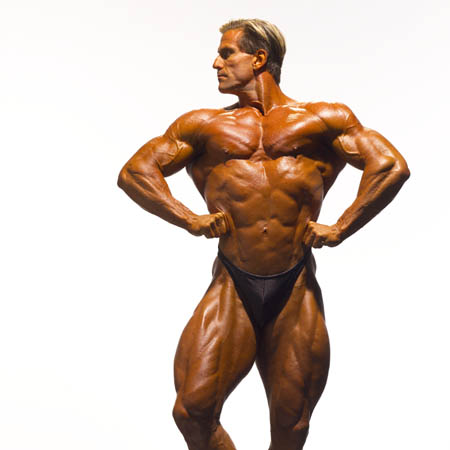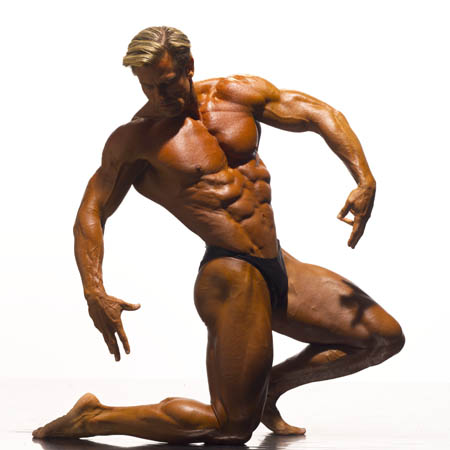| You
cringe..yearly plan? Are you mad? I cannot organize my check
book! It is easy..Start with a weekly or monthly plan first
and see if you can handle it. The principal is start easy and
finish hard. Rest, and do it again. |

|
Cardio
Cardio
training and bodybuilding training can be too much exercise
for some people's body to recover from. Some people may need
to to little or no cardio work, during a muscle building phase,
while others do it daily.
Here's
what I know for sure. Cardio can be a useful tool for losing
fat. It can increase your overall fitness level so that you
can really train hard in the gym. If you can't run a mile,
you can't train very hard. For some people, like ectomorphs
(very thin people) it can stop muscular gains altogether.
These types, might only do cardio for one 3 month cycle a
year, just to establish a base of cardio fitness.
Everyone
needs a base of cardio fitness. After you have it you might
consider doing no cardio at certain times of the year. Especially
before a contest. Too much cardio can thin you down.
Use cardio
to get in good shape 4 months out from the show. Then stop
doing cardio. Now let your diet take off those last 10lbs
of fat, slowly over the remaining 4 months.
By abstaining
from cardio before a contest (and using dieting only to get
"ripped" ) you avoid the slimming effect (and possible
muscle loss) of cardio work. It also helps you stay strong
and lift heavy all the way to the contest. Run in the off
season This can be a valuable way to peak.
People
who are naturally big, the majority of professional bodybuilders,
need cardio to lose fat. These guys are built like sumo wrestlers.
In the summer of 1983 I saw a fellow built like Ray Mentzer
bike for miles near my home in Florida. He was making an effort
to slim down and he was not fat. After months of intense biking
and dieting he was no smaller. In fact he looked more muscular.
His calves were 21 inches cold. He was naturally a big guy
who had to fight putting on body fat but when he lifted weights,
gains came easy. Few people have these "big" people
genetics. Most people are average or thin. If I had followed
this guys routine and calorie restricted diet, I would have
lost 20 lbs at least. Regular people lose muscle doing cardio
too often or two intensely.
BIG
EXERCISES: What exercises should I be doing?
What exercises
should I be doing? That is a common question.
Most exercises
are variations of other exercises. All of us find exercises
that feel "right" or work for our particular body.
Do what feels good for you. That being said there are several
"core" exercises that everyone should be doing if
you have plans of mastering bodybuilding and are serious about
getting stronger.
The idea
is to stimulate muscle growth then get out of the gym. In
your building and strength cycles and even in the pre-contest
cycle these (simple and basic) exercises are the back bone
of your training. As you approach the contest you can add
variations or extra exercises, but keep in mind they are only
extra's or shaping exercises. Stick with the core workout
and you can't go wrong.
Here
are the big exercises:
SQUAT
DEADLIFT
ROW
BENCH
SHOULDER PRESS (with
bar)
Here
is a variation of those exercises:
LEG PRESS
LAT PULLS or CHINS
DB ROWS or PULLOVERS
DIPS
SHOULDER PRESS (with dumb bells)
There are many
valuable exercises but they are variations of these "basic"
exercises. If you can do them..these are the ones to master
before other exercises. A fantastic, strong body can be built
from these exercises alone. Here is a list of the second tier
or exercises. Add these on after you master the others.
ADD ON EXERCISES
LEG CURLS
CALVE RAISES
SHRUGS (all sorts)
BICEP CURLS
TRICEP EXTENSIONS
HACK SQUAT
GRIP EXERCISES
(all sorts)
SHAPING exercises
comprise hundreds of variation exercises. Things like lateral
raises, reverse curls, and so on. These are valuable exercises
but should be done after you are advanced. And if you are
advanced, just doing the basics (progressively) still is the
best way to gain strength. When you are advanced the temptation
is to always do more exercises. Too much and you can hurt
your ability to recover and slow down your progress in the
big basic exercises. My advice is: to
really grow: stick with the basic lifts for several
years (or forever). These exercises never go "out of
style".
|
|
MONTHLY CYCLE
Power Cycle
Each month you start off using weights that are moderate for you.
Train hard for the first week with these weights, but not to the
ragged edge. Week two increase the weight and use techniques to
raise the intensity. The reps are in the 4 to 8 range. Still, hold
back this week. Week three..blast away. Choose a workout this week
and give it 100%! Train till you drop. Train with all out focus
and PUSH HARD!! This should be the gut busting workout of the month.
If you can't use heavier weights, simply use techniques to RAISE
THE INTENSITY!! Week 4 back off and either rest totally (as is often
best) or perform moderate training for 4 to 7 days.
Conditioning
cycle
Lots of sets and reps and moderate weights. Each body part is done
with 2 to 5 exercises with lots of sets. Cardio is done daily. Start
with 3 to 5 cardio sessions during week one and one or two more
during week two and perhaps 7 to 10 cardio sessions in week 3. Week
4, back off to 4 sessions.
Bodybuilding Cycle
Train each bodypart as needed. Once a week go high intensity. Cardio
usually 3 to 7 times a week. This program is simple: during the
first two weeks train with lots of sets and reps. In week 3 train
just like it were a power cycle only not so heavy, but go HIGH INTENSITY
and reduce the number of exercises and sets by at least 60% . During
week four take 3 to 5 days totally off and then go high reps with
light weights and burn the muscles for 2 workouts. Then resume the
cycle with a new month.
So where you are in the
yearly cycle will depend on how well you have trained and structured
your monthly and weekly workouts. The system is based on dynamic
planned change. The body is always adapting to this program.
Planned Progression
(Training cycles also called periodization).
The proper way too look
at this is calling it planned progression.
You have to progress to impact your physique. Yet progress can't
be continual and unrelenting. You can't keep running faster and
faster. You reach a point that only by cycling your training intensity,
can you continue to improve over a career.
It's easy to burn out
or get hurt by trying to be 100% all the time. No one can be 100%
all year round. After you build up to run the marathon or compete
in the Mr. Universe, or a new max bench press, you have to take
a break and build back up into top form, for next time. If you don't,
you will soon go stale and or get hurt and cease all progress as
your body struggles to remain at 100% performance.
The body needs to be
coaxed along by hard work to increase in muscle mass. Slow but steady
progression over a long period of time. It's simple. You back off
from your peak, then build back up again, monthly cycle by monthly
cycle, all the way to a new yearly peak. Each peak, should be higher
than the last.
Some people like longer
cycles. 12 weeks, 24 weeks and so on. I use the monthly cycle within
a 4 month macro cycle. Any cycle is fine. The bottom line is progression.
Planning to progress and willing it to happen, by working out very
hard in the gym, is the key. You want to end
your cycles big. If you are maxing out and doing your
highest weights or highest intensity workouts during the middle
of your cycle, you are messing up. You will burn out and overtrain.
You want to peak at the end of the cycle. Don't burn out early.
Hold back till it's time to let loose.
Then after you have maxed out (on schedule) you allow yourself
time to recover,and then begin training again, starting light and
building back up. Planned
Progression. If
you know you are competing in August, you can plan to lift your
heaviest or engage your most intense workouts at about 6 to 4 weeks
out from the show. This will maximize your muscle mass for the contest
day. Maxing too early or too late can be tricky. You don't want
to go stale. You have to time everything correctly. Be careful not
to get anxious and over do it. Stick to your plan.
As you progress year
after year, you will be amazed by how advanced you become, especially
as compared to where you began. For example, my light week workouts,
would have killed me 10 years ago. But now I am so much stronger
and more fit than I was then, my light week feels effortless, just
as it should. I do 30 rep chins, leg press with 500 for 25 reps,
and it's effortless. By the time I hit my heavy week I am leg pressing
1,400lbs and lat pulling 250lbs x 5, and recovery becomes an issue.
Keep in mind I only use my max weights once
a year, but do a 85% to 90% max each month during my strength and
bodybuilding cycle, using high intensity training methods.
CYCLES
PART TWO: LONG CYCLES
In the book "Brawn" and "Beyond Brawn" Stuart
McRobert describes the essence of correct training. Short, hard,
workouts, once or twice a week of an hour or less in duration, focusing
on basic multi-joint exercises. You rest completely between hard
workouts to allow maximum time to grow. And most importantly you
add a half pound or a full pound or two pounds onto the bar, on
all exercises, as often as possible (every workout or every other
workout). The idea is to progress slowly and for as long as possible.
A cycle like this can go on for years in come cases as the athlete
continues to progress.
Few programs work as
well as this one for adding pure muscle. It's an endless power cycle
in essence. Short, intense and heavy.
Six exercises once a
week. Do 2 or 3 warm up sets, with gradually increasing weights,
and then perform your "max set" and move onto another
exercise.
I have found that every
2 months it is good to take a break from the heavy stuff even if
only for one or two workouts. Sometimes I find one light workout
followed by a heavy one (with one more pound on the bar) works well
when you start reaching your limits.
Overall this is an excellent
way to make progress. Thousands of people have tried this system
and it works. Daily workouts and split routines are great if you
are already big and strong or if you are a professional athlete
of some sort. Otherwise they (daily workouts and split routines)
can often be a detriment to the dedicated athlete who is
not naturally strong before entering the gym.
The simple truth is daily
workouts and split routines often spell disaster and no gains
for the average person. It's way too much weight training for
the average person. This method of training is a way of training
that will work for almost everyone. Steady progress, being careful
not to get hurt (by making big jumps in weight) and using immaculate
form in all exercises (to avoid injury). Each week add a tiny bit
of weight to the bar and keep going. Don't train till you are exhausted.
Don't train for a pump or a burn. Don't rush from set to set. Train
hard of course, but not so hard you risk injury. Steady but continual
progress.
I used this method exclusively
for 6 months and the routine produced tremendous results. I did
six exercises once a week. I got stronger almost every time I lifted.
Usually I would add just one pound or two to the bar. In 28 weeks
I added almost 120 lbs to my squat. Not bad for a guy in his forties.
All my lifts went up and I began my precontest routine (30 weeks)
with more mass than ever.
If you are not experiencing
gains or have not for a while; if you have been stuck in the same
place for a long time in size and strength, are naturally thin,
or perhaps don't have time to train every day, or do
not have the natural recovery ability to engage
and benefit from daily training;
I would strongly recommend you give this method of progression
a serious try for at least one year.
This method can be deceiving.
It looks easy. Done correctly is is nothing but hard work.
Training once a week after several months brings you to new vistas
of recovery and strength. Yes, you get stronger..but the workouts
get harder as well. Add a lb a week to your max deadlift for 5 reps
starting today and let me know how it feels in 6 months. You get
stronger but the workouts, by design, keep you at your limit.
You only need to train
once a week when you train this hard and heavy. Sometimes
even less. It is all about recovery. If you return to the gym and
are not stronger, go home, you are not ready yet.
This form of training
like all weight training is dangerous. You must use good form and
not try to lift more than you can TRAIN WITH. Better to lift less
in perfect form and make real progress than to risk injury and possible
months out of the gym trying to get over that injury. Don't worry,
the weights will be heavy enough in no time.
If you are a rank
beginner just choose a moderate weight to start in all exercises
and build up gradually over time. Warm up well before training and
for each max set. Once a week add a tiny bit of weight and perhaps
some reps to each exercise. In a few weeks perhaps months, you will
be (safely) at your limit.
You have to have mental
resolve and apply yourself consistently to this type of training.
You have to dig in and DECIDE to get stronger. You have to push
yourself without working so hard you lose form or train so hard
it becomes a NEGATIVE FACTOR to your health.





|

